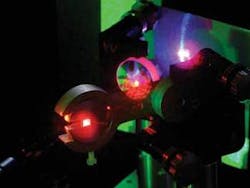A U.K. team has reported up to 120 mW of tunable UV output from an intracavity frequency-doubled vertical-external-cavity surface-emitting laser (VECSEL).1 An optically pumped aluminum indium gallium phosphide (AlInGaP) VECSEL produced more than 1 W of continuous-wave output power at its fundamental wavelength of 675 nm; frequency doubling in a beta barium borate (BBO) crystal generated 120 mW of total output power at 338 nm (see figure). A UV tuning range of 5 nm was achieved with an intracavity birefringent filter.
The team, which includes scientists from the Institute of Photonics and University of Strathclyde (both of Glasgow, Scotland) and the EPSRC National Centre for III-V Semiconductors at the University of Sheffield (Sheffield, England), hopes that this all-solid-state system will be used in a range of applications including biomedicine, atom trapping and manipulation, spectroscopy, lithography, and high-density optical storage.
The VECSEL geometry allows the extraction of a high-power, circularly symmetric TEM00 output beam. Such lasers usually have tuning ranges of tens of nanometers. Frequency doubling—especially intracavity doubling, which takes advantage of the high intracavity powers—has already been used to generate visible light. The availability of newer high-power visible VECSELS offers the prospect of extending this range into the UV. The importance of this has been highlighted by the European Commission, which is supporting the Nano-Photonics Materials and Technologies for Multicolor High-Power Sources (NATAL) project, which concentrates on VECSEL performance across the spectrum. The project started in July 2005 with a total budget of approximately €3.8 million (US$4.9 million).
The latest U.K. research is partly funded through NATAL and partly through the Engineering and Physical Sciences Research Council (EPSRC; Swindon, England). The VECSEL structure was grown by metal-organic chemical-vapor deposition on a 2-in.-diameter gallium arsenide (GaAs) substrate. It has an AlGaAs-based distributed Bragg reflector, on top of which is grown a gain region consisting of 20 compressively strained GaInP quantum wells separated by AlInGaP pump-absorbing barriers. A 4 × 4 mm2 wafer section was cleaved and bonded to a 250-µm-thick single-crystal diamond platelet using liquid-capillary bonding. The wafer and platelet were held in a water-cooled brass mount with a circulating water and ethylene glycol solution at -10°C. The VECSEL structure was inserted as the end mirror in a three-mirror optical cavity with a spherical folding mirror and plane output coupler.
Optically pumped
The laser was optically pumped with up to 7 W at 532 nm from two polarization-coupled commercial frequency-doubled Nd:YVO4 (vanadate) lasers. The pump focus-spot diameter was 75 µm, approximately the same size as the calculated mode diameter. The BBO frequency-doubling crystal has very low temperature sensitivity, making temperature control of the crystal unnecessary. A single-plate, 2-mm-thick quartz birefringent filter, placed in the cavity at the Brewster’s angle, allowed wavelength tuning and narrowed the fundamental bandwidth for more-efficient second-harmonic generation. The two approximately equal-power output beams from either end of the cavity containing the BBO were combined to give a total UV power measurement.
“This all-solid-state system shows promise as a compact, high-power continuous-wave laser at 337 nm to rival nitrogen lasers, and has the added advantage of straightforward wavelength tuning,” says Institute of Photonics team leader Jennifer Hastie. “Using other designs for a AlInGaP gain structure, continuous spectral coverage at least in the range of 325 to 345 nm should be possible with this approach.”
REFERENCE
1. J.E. Hastie et al., Appl. Phys. Lett. 89, 061114 (2006).
